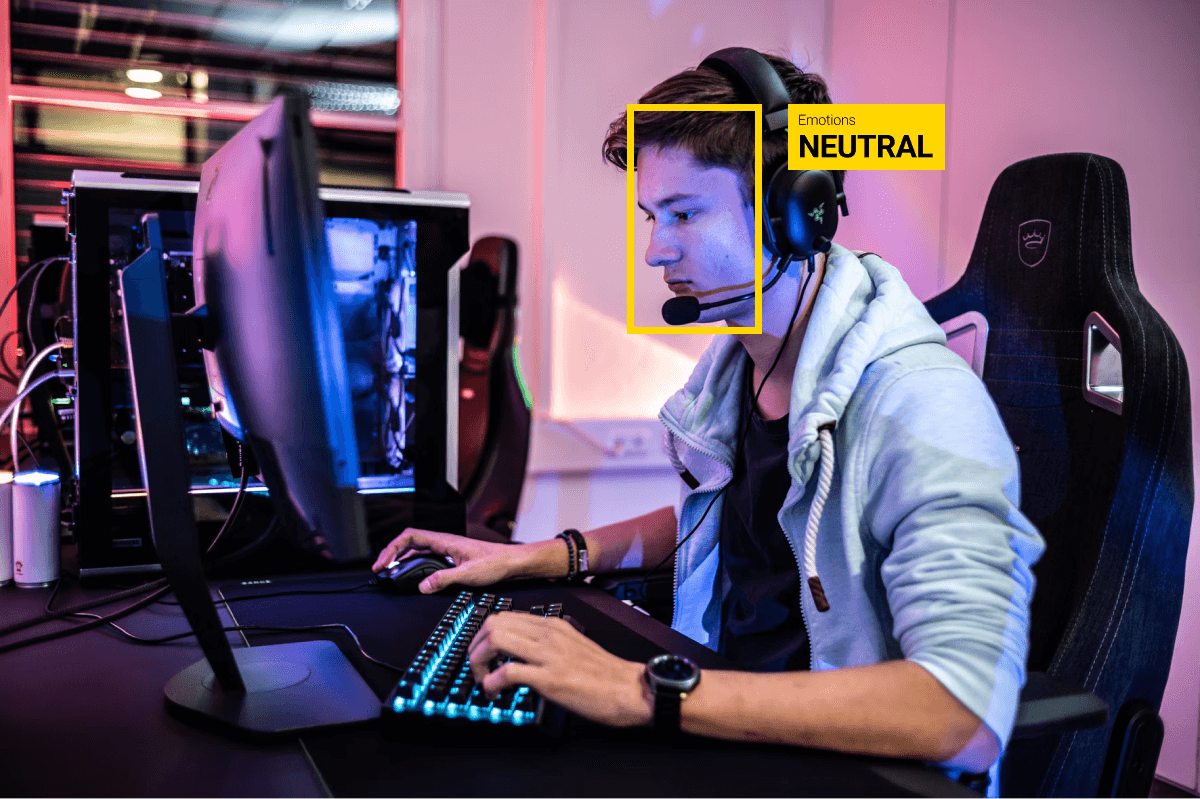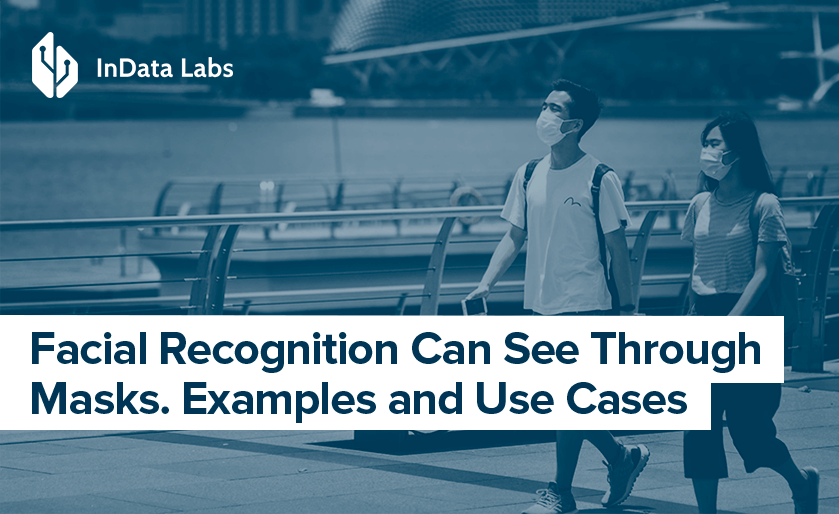Nowadays it’s not enough for companies to detect your face features. Thereby, AI facial expression recognition has mutated into a new form of intelligence.
We are talking about inferring emotions with Artificial Intelligence, of course. Reading emotions with the help of AI cannot yet substitute our innate ability to distinguish between psychological states. However, it is now a budding industry that will grow to $85 billion by 2025.
So, let’s prepare for the new technological breakthrough. Today, we will explore the nitty-gritty of facial expression recognition techniques and how computer vision accelerates their use.
What Is Facial Expression Recognition Algorithm?
During the pandemic, we’ve seen an influx of AI emotion technologies. The whole world has suddenly become interested in automated facial expression recognition (FER) systems.
China has especially been proactive in adopting emotional intelligence. For example, one can see Taigusys systems being installed in about 300 prisons and detention centers around China. The systems, among other things, predict dangerous behaviors by reading emotions.
While it may sound dubious or concerning, face recognition solutions are gaining momentum.
But what is facial expression recognition, anyway?

Source: Unsplash
Emotion detection technology refers to computer systems that identify the psychological state of humans. The systems use biometric markers to accurately scan the emotion.
Essentially, face recognition technology is a sentiment analysis tool. However, its capabilities are limited to six basic expressions. Typically, it interprets happiness, sadness, anger, surprise, fear, and disgust.
This universal set of emotions sparks up debates. The main reason for that is that emotions are expressed differently across cultures and societies.
But that’s all we have for now.
How Does Emotion Analysis Work?
Face detection in general is a computer vision problem. Hence, the facial expression recognition model relies on the knowledge body of Artificial Intelligence.
Also, it is computer vision that enables machines to recognize objects in a way that simulates human sight. So whether it’s road danger detection or emotion recognition, the goal is the same. The system should be able to make decisions based on image interpretation.

Source: Unsplash
Facial Expression Recognition Algorithm: Step-by-step
Let’s have a closer look at how FER analysis works. It usually entails three main steps.
Step 1. Face Detection
During this step, a computer application captures a digital image of an individual’s face. To do that, it needs to find the coordinate of the face in the image.
The source of the visual input may come in different shapes and forms. It can be images and videos from surveillance cameras or biometric camera systems.
Facial coding systems also allow for inexpensive camera hardware. It means that you can even infer emotions via laptop or smartphone cameras. Thus, emotion recognition becomes possible in naturalistic environmental settings. These may include homes, public transportation, personal vehicles, and others.
From a technical standpoint, face recognition applications development relies on deep learning. It is possible to detect faces with statistical learning algorithms such as linear regression.
However, deep learning allows you to perform the task with no human participation. All you need is to choose a prebuilt algorithm and train it with enough data.
Step 2. Facial Expression Detection
Facial expression recognition models then analyze facial landmark positions. They do that by tapping into a facial expression database. Hence, it can be eye corners and nose corners that will respond to a certain feeling. Besides, the system can analyze changes in landmarks if the data is derived from a video.
Step 3. Emotion Classification To A Psychological State
Finally, the face detection and facial expression recognition system classifies the expression. This is possible due to the statistical comparison of data sets. Thus, a particular facial look can be grouped into basic emotions or compound ones.
The set of basic emotions includes:

At the same time, compound emotions present a combination of the above. The face can be classified as sadly surprised or happily sad.
A facial expression recognition algorithm can also come with biometric identifiers.
Besides computer vision, FER systems have been leveraging techniques from other areas, including:
- signal processing – emotion recognition system based on the processing of multiple physiological signals;
- machine-learning – automatic facial expression recognition using machine learning and deep learning;
- and speech processing – real-time facial expression recognition techniques using a pre-trained image classification network.
As for the models, face detection and facial expression recognition system may include:
- Bayesian networks – a probabilistic graphical model that represents probability computations;
- Gaussian Mixture model – parametric probability density function;
- Hidden Markov Models – generative approach for modeling biological sequences;
- Deep neural networks – machine learning algorithms based on Artificial Intelligence.
Now we fully acknowledge the complex nature of emotion recognition using facial expressions. Let’s see how popular face recognition applications can make our lives easier.
How Can We Benefit From Facial Expression Recognition Model?
Automated facial expression recognition systems are a valuable asset for industries. The software transforms raw emotional responses into actionable data. Therefore, it has never been easier to gather real-time customer responses towards a product. But the added value of FER systems goes beyond marketing.
Public Safety
Computer vision and emotion analysis can make the world a safer place.
End-to-end public safety software will climb to over $50 billion by 2025. The main driver of smart safety solutions is raising awareness about the importance of security. Legacy architecture and dangerous industrial explorations also contribute to the AI-based approach.
In particular, intelligent emotion analysis permeates such applications as:
- lie detectors and smart border solutions to capture high-quality biometric data;
- interpreting and predicting potential terrorism threats in public spaces;
- crime scene investigation to analyze potential motives in a crime.
Crime Detection
Smart cameras in urban areas store an enormous number of image samples with time and location labels. The data of this magnitude allows authorities to make data-driven decisions.

Source: Unsplash
Among such decisions is crime prediction. Systems transform data on emotions into measurable data and use it to prevent crime.
According to research, emotion data uncovers the interaction between emotions and crimes. Hence, emotion recognition from facial expressions can improve the performance of crime prediction.
The potential applications of facial expression analysis include:
- detecting insurance claim frauds;
- fraud prevention;
- preventing shoplifting, and others.
Customer Behavior Analysis And Marketing
As we’ve said, sales are among the most famous face recognition technology industries. It’s a hot task in marketing since emotions drive customers to purchases. If marketers can elicit emotions, they will tweak their campaigns to a tee.
And this robust marketing tool has already gotten off the ground. Thus, the Innerscope company leverages biometrics and brain scans. They target this combo to evaluate subconscious emotional responses to media and marketing.
Another prominent example of real-world AI emotion analysis is Kellogg’s company. They used FER software to scan engagement rates for their ad. Viewers were shown multiple versions of a Crunchy Nut cereal commercial. After analyzing their emotions, the company rolled out the ad that produced the desired engagement levels.
Video Game Testing
Expression analysis is also a worthy technology for the game-calibrated experience. First of all, it can help gaming companies monitor response during the testing phase. This way, game developers can elicit insights and incorporate them into the final product.

Source: Unsplash
The best thing about such feedback is its non-intrusive nature. Gamers can enjoy the gameplay and contribute to the creation of an engaging user experience.
Also, biometric testing from home can also improve gameplay and generate better interfaces.
Healthcare
Emotion recognition and healthcare surveillance systems seem to be made for each other. We’ve already seen numerous researches that demonstrate the effectiveness of the technology. Also, smart emotion analysis can help build smart healthcare centers that can detect depression and in order to start the treatment early.
Other potential applications in the medicine area include:
- detecting autism or degenerative nerve diseases;
- preventing severe mental disorders or depression to identify patients that need medical help;
- preventing suicide;
- patient monitoring during treatment.
However, further development is necessary for practical use.
Employment and Human Resources
Finally, HRs can use FER systems to understand the credibility of a candidate. The software can analyze facial expressions and intonations. In a way, it’s like a lie detector for HRs. But the result of this analysis will be detecting the level of motivation and honesty of a particular candidate.
An example is a B2B AI-powered SaaS platform of X0PA Ai. It embeds Microsoft’s Video Indexer to enable smart video interviewing and analytics capabilities. By engaging video and audio models, it uncovers business insights, including emotional analysis.

Source: Unsplash
Besides HR decision-making, intelligent emotion monitoring can evaluate the moods and attention of employees.
Behind The Mask Of Facial Expression Analysis
Turning human expressions into a data source has recently become the focus of various industries. The practical benefits of emotion recognition from facial expressions bode well for numerous businesses and for society as a whole. From healthcare to public safety, emotion analysis allows us to tap into the minds of customers and boost their experience.
However, we haven’t yet witnessed its might. So in the coming years, we’ll certainly see more smart emotion analysis assuming the stigma around it will melt away.
Need an AI consultant and software development partner?
Schedule an intro call with our consultants to explore your business needs and find out how we can help to achieve your goals.



